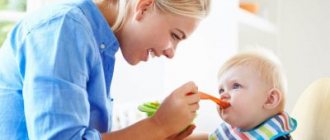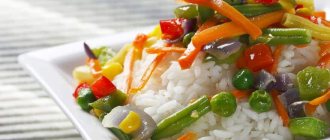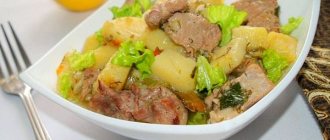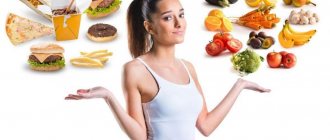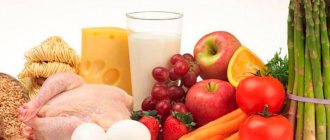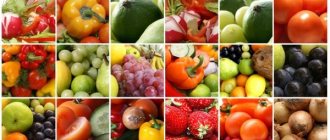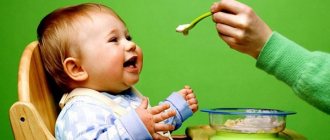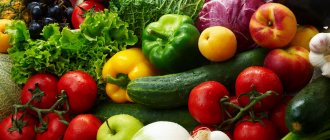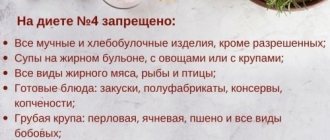The children's digestive system is physiologically different from that of adults. Developmental delays and acute reactions to stale, low-quality products cause food poisoning. The body is simply not able to resist harmful bacteria, since immunity to all foreign substances has not been developed. Digestive disorders in childhood are diagnosed very often. One of the most effective ways of recovery is considered to be diet after poisoning in children. By providing the child with proper nutrition, parents help the body cope with damage and reduce rehabilitation time.
Features of the child's body
Feeding children should be taken seriously. Below are the main features of the child’s body that should be taken into account when creating a menu after poisoning.
- A child's body grows and develops very quickly and needs a complete daily supply of proteins, carbohydrates and fats. A child who is poisoned should not starve.
- The digestive system in young children is not fully developed. For faster absorption, it is advisable to chop or twist dietary foods.
- During preschool age, children's teeth begin to fall out. When feeding your baby, think about his ability to chew food thoroughly. Swallowed large pieces of food will irritate the gastric mucosa, which is inflamed after poisoning.
Remember that dietary nutrition in case of poisoning must be prescribed and described in detail by the treating pediatrician. It should take into account the characteristics of a particular organism and concomitant chronic diseases.
What to give when vomiting?
Rules to remember in case of food poisoning with vomiting are:
- To restore the water-salt balance in order to reduce the loss of fluid and electrolytes by the body.
- To provide gentle conditions for the normal functioning of the digestive tract, which will soothe irritated mucous membranes.
- Providing the body with the necessary vitamins and nutrients so that the body can better cope with the pathological process.
https://youtu.be/Jz14S3NMEnM
What are the basic dietary rules for children?
What to feed a child after vomiting? Diet after food poisoning is a mandatory component of treatment. In its absence, any treatment of the baby will be ineffective. Below are the basic rules and recommendations for feeding a child after poisoning.
- Follow your diet. You need to eat often and in small portions. Children's nutritionists recommend eating a little food every 2-3 hours. The size of a baby's single serving should not exceed the size of his palm. This diet helps improve intestinal motility and regulate the functioning of the pancreas and liver.
- Prepare your child's meals in the oven, steamer, or boil. These cooking methods help retain the nutrients in the food. Food prepared using these dietary methods does not burden the digestive system and is easily digested.
- Provide your baby with separate meals. There is no need to mix protein and carbohydrate foods. For example, it is better to eat chicken and porridge separately from each other. Separate nutrition ensures easy digestion.
- Food and drinks should be at room temperature. Hot and cold irritates the mucous membrane of the esophagus and stomach, slowing down recovery.
Remember that in case of food poisoning, children are strictly prohibited from giving fried, smoked, spicy and fatty foods.
What is the danger of food poisoning in a child and how to identify it
In summer, in hot weather, bacteria and microbes multiply more actively. The likelihood of developing and developing digestive disorders increases, but food poisoning is not a seasonal disease. Children can get poisoned at any time of the year. There are many causes and ways of infection, most often unwashed hands, improper storage and preparation of food, and expired products.
When a child’s body is damaged, pathogenic microorganisms begin to release toxins. This happens very quickly. During the day, the condition can sharply worsen and it is almost impossible not to notice negative manifestations. The body reacts with symptoms typical for this condition. Mild forms of poisoning are characterized by malaise, moodiness, lethargy, rapid pulse, and refusal to eat. More serious changes in the condition of children occur when so-called aggressive signs appear. These include vomiting and diarrhea, complaints of abdominal pain, and dizziness.
Frequently recurring attacks of vomiting and increased body temperature indicate the onset of intoxication. This is one of the most dangerous consequences of poisoning. The infection spreads throughout the body and negatively affects the functioning of vital organs. The liver, pancreas, and mucous membranes suffer. There is a risk of the occurrence and development of diseases such as gastritis, pancreatitis, pancreatic dysfunction, and colitis. In severe cases, the sick child urgently needs help. Do not try to treat the disease yourself. The doctor will do it better and without health consequences.
It is possible to take measures and eliminate unpleasant symptoms at home only in case of a mild form of poisoning. Dietary nutrition helps restore the functioning of the digestive system. The menu for children after poisoning includes taking safe foods and following a meal schedule. By following the rules, you will help your baby, but be prepared for a long rehabilitation period. It will not be possible to eliminate the consequences of poisoning in 2–3 days. To fully restore the child’s body, the dietary regimen must be followed for at least a week, depending on the severity of the poisoning.
Features of the drinking regime
Drinking regimen is an integral part of the diet in case of poisoning. The child's body loses a large amount of fluid through vomiting and diarrhea. You can make up for these losses by drinking plenty of fluids. It is best to drink little and often. It is optimal to drink 1 tablespoon of liquid every 10 minutes.
Please note that in case of severe poisoning, with severe intoxication, dehydration of the child is treated in a hospital setting. The required amount of fluid is administered intravenously.
Drinks allowed for poisoning in children:
- non-carbonated mineral water with an alkaline pH, for example Borjomi;
- lightly sweetened black tea;
- dried fruits compote;
- table water.
In case of poisoning, it is forbidden to drink freshly squeezed or store-bought juices, strong tea, sour or carbonated drinks.
Symptoms of poisoning
It is not difficult to recognize poisoning by its symptoms. These include:
- Nausea, loss of appetite;
- Vomit;
- Intestinal disorder, expressed in diarrhea;
- Fever;
- Pain in the gastrointestinal tract;
- Weakness, fatigue, lethargy, apathy.
Food poisoning in children is dangerous due to subsequent complications. You have to act at the first sign. Take primary measures: rinse the stomach, drink activated charcoal. Contact your doctor immediately for treatment.
Dangerous consequences include:
- The occurrence of an inflammatory process in the gastric mucosa;
- Disruption of the pancreas, damage to its tissues;
- Inflammation of the large intestine due to infection.
During treatment, the doctor’s instructions are strictly followed. A diet is often prescribed for a child who is poisoned. The recovery period takes longer than in an adult. You need to be patient. Don't be discouraged: the diet is beneficial. There are delicious dietary recipes that children can enjoy. You just have to show your imagination.
1) Crying, behavior changes.
https://youtu.be/XfIoms5iWRQ
Crying is a child’s reaction to discomfort and pain in the abdomen. In addition, crying can be one of the signs of toxic damage to the nervous system, which often manifests itself as a complication in babies. The child may become highly excitable or, conversely, inhibited. Be sure to tell your doctor about any changes in behavior.
2) Vomiting
The first defense mechanism. If vomiting does not appear even after diarrhea, you should rinse the stomach by letting the baby drink boiled warm water until nausea appears.
Important! Do not give your child antiemetic medications immediately when vomiting occurs! This is a powerful defense mechanism of the body that frees it from toxins. The same applies to diarrhea - there is no need to “turn off” the intestines, as this will prevent it from getting rid of harmful substances.
3) Diarrhea
Diarrhea occurs after the pathogen invades the walls of the gastrointestinal tract.
In case of poisoning, the function of the pancreas, whose enzymes help digest fats, is impaired. Therefore, the peculiarity of the stool will be the appearance of a strange odor, white, yellow, green or other light shade, shiny, “greasy” sheen.
4) “Dry crying”, “dry diaper”, dry mucous membranes, sunken eyes.
A dangerous sign indicating dehydration! Vomiting, diarrhea and increased sweating lead to an imbalance of water balance: the amount of water in the body drops below the physiological norm2.
5) Increased body temperature.
Warns of the presence of a “fight” between the child’s body and a pathogenic agent. The temperature should be reduced when it rises above 38 - 38.5 ° C. First, try to cool the baby down using physical methods - ventilate the room well and place a cool, damp towel on the baby's head. Fluctuations and duration of fever may depend on the amount and type of pathogen, individual characteristics of the body and other conditions.
Poisoning is the process of intoxication of the body. Toxins can get there in different ways: through food, through the air with toxic impurities, through medications, etc. Types of food poisoning:
- microbial;
- non-microbial;
- poisoning of unknown etiology.
The causative agents of microbial poisoning are microorganisms. They settle in products that do not pose a potential danger. Infection occurs if a person neglects simple rules: eats a half-raw dish or eats dirty foods. This form of poisoning is often confused with infectious diseases - dysentery, salmonellosis, etc. Pathologies have similar symptoms, treatment tactics are different.
Non-microbial poisoning is a consequence of eating potentially dangerous foods, such as poisonous mushrooms or berries. The toxins they contain cause intoxication of the body, provoking symptoms of poisoning in adults and children. That is why it is important to explain to your child that eating unfamiliar foods is deadly. Poisoning of unknown etiology affects people living in a certain area (ciguatera, Kashin-Beck disease, etc.).
What can you eat on the first day of poisoning?
According to the new WHO protocols, you need to start feeding your child on the first day of food poisoning. Previously, it was believed that you need to fast for the first few days.
The diet after poisoning in children on the first day of the disease is strict. The list of foods that can be given to a child during this period is limited. It includes the following dishes:
- boiled rice or oatmeal with a slimy consistency;
- biscuits without any flavoring additives;
- toasted white bread.
Diet to restore the body
When compiling a dietary diet, one should take into account the signs of poisoning, what exactly dominates the patient: vomiting, diarrhea, or both conditions are observed simultaneously.
The therapeutic diet will depend on what is more predominant: vomiting or diarrhea
The diet should not only restore the substances excreted from the body as much as possible, but also have a gentle effect on the inflamed mucous membrane of the gastrointestinal tract.
Diet conditions
- Drinking regime. As mentioned above, you need to pay close attention to this factor. Due to the large loss of fluid, all metabolic processes in the body are disrupted, blood density increases, which can cause heart failure and other very unpleasant complications. The child must be given water not only at his request, but also under compulsion; the moisture balance should not be restored, but increased in comparison with the normal state.
The child must be given water, even if he does not want to
For every kilogram of weight of a one-year-old child, it is recommended to give 150–200 ml of liquid; older children are given approximately 120 ml of liquid per kilogram of weight. You should drink regularly, in small portions; too large portions may cause vomiting.
You can drink a little from a spoon, but very often
This is not bad; vomiting removes poisons well, but after vomiting the amount of liquid you drink should be increased. Rehydration must be carried out throughout the entire period of vomiting and diarrhea, and subsequently the volume of fluid drunk must be normalized to physiological norms.
- Diet. During the acute period of the pathology, it is not recommended to give food, especially if the child has no appetite. In the future, a gentle diet is prescribed; feeding should be divided up to seven times a day, but in small portions.
There is no need to force your child to eat if he doesn’t want to.
Lack of appetite for healthy foods does not mean that you can allow your baby to eat snacks and other unhealthy foods. Children always have a good appetite for these foods, but it is caused not by the physiological needs of a weakened body, but by special chemical food additives that cause dependence on these foods.
After poisoning, a child should not be given various harmful snacks.
Need for vitamins and proteins
During illness, along with dehydration, the body feels an acute lack of vitamins; it is impossible to replenish their balance only through proper food. Moreover, the amount of food is significantly reduced. Doctors recommend consuming a complex of vitamins A, B and C for three to four days; they will improve metabolic processes and restore the body’s resistance.
As prescribed by the doctor, the child should be given vitamin complexes
At the same time, attention should be paid to proteins, especially of animal origin; it is best to increase the dose of dairy products. The fact is that the protein they contain has a lipotropic effect, which has a beneficial effect on the liver. The liver suffers greatly during any food poisoning and requires increased attention during the recovery phase.
The emphasis should be on dairy products, which will help restore the liver
As for other fats, their amount should be reduced by at least 15% compared to the diet of a healthy child. Only as the patient’s condition stabilizes can the composition of the diet gradually approach the usual diet.
The amount of fat during the diet should be reduced
In all cases, you need to remember that various digestive disorders in children occur very often, there is no need to make a tragedy out of this and panic. The baby’s body can cope with the problem itself, it just needs to not be disturbed.
Diet for babies
In all cases, the healthiest food product for babies under one year of age is breast milk. By the way, if you feed your child regularly, then eating disorders almost never occur. During an exacerbation, complementary feeding should be excluded and the baby should be switched to breastfeeding only.
For young children, the best medicine is breast milk
As your condition improves, you can gradually add rice porridge with water or diluted milk, baby cottage cheese and vegetable purees. Juices can be given only after the signs of poisoning have completely disappeared; the amount should be increased gradually.
Gradually, you can introduce vegetable purees into your baby’s diet.
Nutrition for children aged 1–3 years
The main differences are not in the composition of the diet, but in the serving size. One-time volumes are increasing, various products can be added on the second day after the situation has stabilized. If vomiting is observed immediately after eating, then food intake should be stopped and only given to drink. Preferably fermented milk products, but only of natural origin.
If your child continues to feel nauseous after eating, you can give him fermented milk drinks.
It should be remembered that so-called fruit yoghurts have nothing to do with fruits and berries. They add appropriate dyes and flavoring chemical additives; these components have an extremely negative effect on the child’s weakened body.
Fermented milk drinks with different flavors should not be given to a child during a diet.
According to the consistency of the dishes, they should first be liquid, then puree, and only on the third day are they allowed to give solid food. It is not recommended to give cow's milk during the acute period of food poisoning; it can cause diarrhea. Milk enhances fermentation processes in the intestines, and this is an undesirable phenomenon during the recovery period of the gastrointestinal tract.
It is better not to give milk in its pure form to your baby during a diet.
Diet for diarrhea
The duration of diarrhea depends on the degree of poisoning of the body and its protective physiological capabilities. The main requirement for food products during this period is that they should not have a laxative effect.
Foods that weaken you should be excluded, especially if diarrhea continues
It is not recommended to eat baked goods, smoked meats, or milk. Temporary refusal of food is allowed only if pain in the abdomen intensifies after taking it. This condition cannot last more than a day; if there is no positive dynamics, then on the second day you need to see a doctor.
If diarrhea continues on the second day, you should consult a doctor.
How to cook food
Food should be crushed or pureed, but such a requirement exists only for the first days of the acute period of the pathology. Cereals need to be cooked longer than usual, and before serving, grind them in a blender. You can give rice water. Ready-made baby products have proven themselves to be excellent; they can also be fed to older children. Various soufflés, porridges and purees meet all the requirements of doctors. It is advisable to initially choose those baby products that contain a minimum amount of sugar.
In the first days, ready-made baby purees are excellent for the diet.
Food should be at room temperature, not too hot or cold. Such food is not only poorly digestible, but also irritates the mucous membranes of the gastrointestinal tract. Hard-boiled eggs, rice and cottage cheese have fixing properties. If the diarrhea is not very severe, then using these products you can improve the child’s condition.
Boiled rice is an excellent fixing food.
Food poisoning is not a child’s condition that requires complex drug treatment. Modern medicine claims that it is strictly forbidden to give medications to children under the age of one year; such treatment is prescribed only in extreme cases.
There is no need to take any specific medications, especially antibiotics, during normal poisoning
It is during this period that a person’s health is laid for life; one cannot interfere with natural processes.
Complete refusal to eat in the first hours after poisoning is a normal state of the body, and not a deviation requiring immediate intervention. You can give food only after the child asks. You should only be forced to drink plenty of fluids; dehydration of the body can occur very quickly and have the most severe consequences. Shingling pain, you can find out at the link.
Allowed products on subsequent days
What to feed a child after poisoning? Dietary nutrition should be followed for at least a week after the development of foodborne toxic infection.
The following is what you can eat after the first day of poisoning:
- low-fat chicken broth prepared without spices from the sirloin. It can be eaten with toasted white bread;
- boiled lean chicken or turkey meat. For easier digestion, the meat can be twisted or blended in a blender;
- vegetable puree soup with potatoes, carrots and zucchini;
- rice and oatmeal porridge boiled in water;
- bananas are the only fruit that can be eaten fresh if poisoned;
- apples baked in the oven or microwave;
- You can start eating low-fat cottage cheese, kefir from 4-5 days;
- low-fat sea fish (stewed or baked in the oven);
- boiled eggs or steam omelette cooked in milk;
- boiled potatoes, carrots, zucchini and pumpkin.
Foods you shouldn't eat
In the case of an eating disorder caused by poisoning, children should not be offered:
- pasta;
- fatty meats;
- bakery products;
- smoked products and canned food;
- sweets in the form of chocolate and candies;
- legumes, including beans, lentils or peas;
- uncooked vegetables, fruits or berries;
- Cereals containing gluten, including pearl barley, barley or millet.
If a child is vomiting, it is better to exclude meals. Drinking a teaspoon at an interval of 5-10 minutes will help you best here. After the exacerbation period is over, you can initially offer the baby sweet tea, and a little later crackers.
A day after the cessation of diarrhea and vomiting, you can enter into the menu:
- boiled poultry and fish;
- low fat kefir;
- mashed potatoes, but without adding oil;
- low-fat chicken broth with the addition of pureed vegetables;
- steamed cutlets with rice as a side dish;
- compotes of dried fruits, including raisins or rose hips, as well as rice decoctions.
Along with the dietary regimen, the child must be given sorbents that will cleanse the intestines of toxins.
Prohibited Products
The list of prohibited foods and dishes after food poisoning in children is very wide. It consists of food that negatively affects the digestive system and metabolic processes in the baby’s body.
In case of poisoning, the following foods are strictly prohibited for children:
- fatty meats and fish;
- hard cheese;
- sausages, frankfurters, sausages, bacon and lard;
- meat by-products (liver, kidneys, stomachs, tongue, brain, lungs);
- store-bought semi-finished products;
- chocolate;
- confectionery flour products, cakes, marmalade;
- all fried or smoked products;
- fresh berries, fruits and vegetables (except bananas);
- cocoa, coffee;
- mushrooms;
- pickled and canned foods;
- ketchup, sour cream, mayonnaise, hot spices;
- various candies, marshmallows;
- sweet carbonated drinks;
- pasta.
Recommendations for preparing dietary food for a child
In case of poisoning and during the recovery period, it is advisable to offer the child only heat-treated foods in liquid and semi-liquid form. To grind food, you can use a blender or a sieve to grind it. You can return to the usual type of food after the digestive process has been restored.
Dietary meals can be prepared in the following ways:
- boil;
- stew;
- bake;
- prepare for steam.
It is strictly forbidden to offer your child fried and grilled foods during the diet. You should also exclude canned food, pickles, sauces and marinades, spices, and dyes from the child’s diet, since all of this has an irritating effect on the gastrointestinal mucosa and negatively affects the child’s liver.
Features of preparing individual dishes:
- Porridge: should be cooked until liquid and boiled in milk diluted with water in a 1:1 ratio. It is better to give preference to rice and liquid oatmeal, as they help improve digestion.
- Soups: You can prepare vegetarian vegetable soups or soups with low-fat meat broth. Greens are allowed to be added, but in slightly smaller quantities than usual.
- Meat and fish: at first it is recommended to offer it to the child in the form of a soufflé.
Meat soufflé recipe
Ingredients:
- lean meat – 60 g;
- white bread – 5 g;
- egg - one quarter of it;
- butter – 0.5 tsp;
- low-fat broth - 1-2 tbsp. l.
Preparation:
- Cut the cleaned lean meat into small pieces. Throw it into the pan to simmer until half-cooked, and add a little water there. Soak the bread in cold water.
- We pass the stewed meat and softened bread through a meat grinder twice. Add the egg and broth to the mixture and mix thoroughly.
- Place the resulting mass in a baking dish, pre-greased with oil and sprinkled with breadcrumbs. Close the mold tightly with foil.
- Place in the oven in a “water bath”, which will ensure even baking of the soufflé, for approximately 20-25 minutes.
Larisa Tokareva, pediatrician
41, total, today
( 194 votes, average: 4.58 out of 5)
Soy sauce: benefits and harms
What fruits can you eat if you have gastritis?
Related Posts
How to buy and choose products correctly
If a child develops food poisoning, you need to pay special attention to your food purchasing choices. Below we have compiled recommendations for you that will help you purchase safe and healthy food for your baby.
- Buy products only from certified outlets. Avoid spontaneous markets and kiosks. It is best to buy them in large supermarkets or official markets.
- Feel free to ask for invoices and product inspection results. Sellers are required to present these documents to buyers.
- Check the expiration date of products. Expired goods can lead to re-poisoning. Please note that you need to look at the factory production date. In stores, they sometimes paste it with a newer date.
- Pay attention to the appearance of the product. For example, bananas with damaged skins can be dangerous.
- Smell the meat when purchasing. Fresh, chemical-free meat does not smell of anything. But meat parts that are not fresh are treated in stores with formaldehyde or chlorine. A child's weakened body may react negatively to such stale meat treated with chemicals and may become poisoned again.
- Do not purchase frozen foods (meat, fish, vegetables). You have no way of knowing how many times they have been defrosted and re-frozen. Such food can be hazardous to health.
- Do not buy ready-made meals for your child in stores or restaurants. You can be confident in the quality and safety of food only if you select and prepare the products yourself.
Products the use of which is not allowed in case of intoxication in children
There are a number of products, the use of which in case of intoxication in children is prohibited:
- pork, lamb;
- fresh apples, pears, peaches, citrus fruits, currants, raspberries;
- barley, wheat cereals;
- cow's milk;
- pasta;
- various types of smoked meats;
- sausages;
- soft bread;
- baked goods, cookies, cakes;
- sweets, candies, chocolate;
- any sour juices;
- seafood;
- any canned food.
Diarrhea, vomiting, hyperthermia contribute to the fact that the child’s body not only becomes dehydrated, but along with the fluid, a large amount of minerals is removed from the body. Strict adherence to dietary recommendations will help prevent general exhaustion of the child’s body and relieve serious complications.
An example of a nutrition menu for a child after poisoning
The table below shows an example of a daily food menu for a child after food poisoning.
| Eating | Food |
| Breakfast |
|
| Afternoon snack |
|
| Dinner |
|
| Snack |
|
| Dinner |
|
Between these meals you can have small snacks. The child should not feel hungry or overeat. You can use this menu as a guide when planning your child’s diet.
What can you eat?
For babies, breast milk remains the best nutrition.
In a situation where the child has already begun to be fed, it is better to exclude complementary foods during the period of acute food poisoning.
Gradually, it will be possible to introduce dietary foods into the baby’s diet in small doses.
For older children, the following products are recommended:
- Dried fruits - dried apricots, prunes, etc.
- Cereals, including buckwheat, rice and oatmeal.
- Baked fruits including apples and bananas.
- Fish, here preference should be given to marine varieties.
- Chicken eggs, you are allowed to consume half the yolk per day.
- Lean meats, including chicken or rabbit, are best served in soufflé form.
- Wheat bread, which can also be dried and eaten as is.
- Cooked beets, carrots, cauliflower, tomatoes and broccoli. It is better not to rush into introducing potatoes into your diet, since this vegetable is a source of complex carbohydrates.
- Decoctions based on dried fruits, which are filled with vitamins and minerals, as well as fruit jelly, weak black or green tea with the addition of honey or sugar, teas based on medicinal herbs, including rose hips, lemon balm, and currant or raspberry leaves.
Features of preparing chicken broth
You can feed your child chicken broth on the second day after poisoning.
This dish helps replenish protein losses, restore strength and launch the motility of the digestive system. Nutritionists consider chicken broth an integral part of nutrition for foodborne illnesses. This broth is made from chicken sirloin. This kind of meat is the most dietary and lean. You should eat the broth and the chicken meat from it separately.
Diet is an essential component of the treatment of poisoning in children. It is prescribed by the treating pediatrician. You need to stick to the diet for 1-2 weeks. All products should be easily digestible, cooked in a double boiler, oven or boiled. Your child needs to eat often and in small portions. On the first day of illness, you can only eat biscuits, dried white bread and rice porridge with a slimy consistency. In subsequent days, the diet expands.
Diet, nuances of preparing food for a child in case of poisoning
During acute symptoms, oral rehydration measures are recommended. To do this, the patient must drink a special water-salt solution in a certain amount. Ready-made pharmaceutical mixtures contain the necessary microelements. You can buy this powder at a pharmacy.
We invite you to familiarize yourself with the diet of a child aged one and a half years.
The daily dose of the solution is determined based on the body weight and age of the child. For every kilogram of weight within 24 hours, the child should drink:
- up to 1 year – 150-200 ml;
- from 1 year - 120-170 ml.
Poisoning is accompanied by a change in the acid-base balance with diarrhea and vomiting, which results in dehydration of the body. This leads to thickening of the blood and increasing slagging in the body. First of all, the goal is to ensure proper drinking regime. For acute food poisoning, give a special saline solution to drink.
To prepare it, use salt, soda, potassium, and glucose. It is easy to purchase a water-salt solution at the pharmacy. It's convenient: you don't need to waste time on preparation. The powders already contain the required amount of substances; just stir them in a glass of water. The instructions for the medications indicate the dosage. Daily consumption of the solution is provided based on weight and age.
There is still a possibility of provoking vomiting through this drink. In this case, it is recommended to offer the child 1-2 tsp. with a time interval of 10-15 minutes. The solution should be warm, at room temperature. It is possible to dilute the hydro-salt drink with weakly brewed tea or herbal decoctions for children 4-7 years old.
After vomiting and diarrhea stop, you must also follow the drinking regime.
- On the first day, the amount of food consumed is limited to the maximum. The emphasis should be on drinking: water, decoctions, teas. If necessary, hydrate the body.
- The next day, you are allowed to feed the child by offering porridge: well-cooked buckwheat, rice. Give wheat crackers to eat with weakly brewed tea. Helps stop vomiting and diarrhea.
- After the acute period, it is permissible to add light vegetable soups, fermented milk products limited in fat content, and dietary meat to the diet. Add oatmeal to breakfast. Dairy products are necessary to restore the child’s intestinal microflora.
- Gradually, over the course of two weeks, it is allowed to feed the usual food.
Food poisoning brings discomfort into life. They negatively affect the overall well-being of the child. In order to speed up the recovery process, it is necessary to choose a properly balanced diet.
The diet will help eliminate the symptoms of poisoning and bring the body back to normal.
Diet for a small child
An infant can only eat mother's milk
If an infant under one year of age has been poisoned, he can only eat mother’s milk, even if his mother had previously started feeding him complementary foods. You can diversify the diet of a baby up to a year only after his digestion has normalized and vomiting has stopped.
If the child is on artificial nutrition, then you should choose buckwheat or rice mixtures diluted with water for him. The diet of a slightly older baby (from 7 months to a year) is more varied: buckwheat, rice porridge, puree soup. If a child is poisoned, especially a small one (up to a year), a doctor should treat him. It is worth checking with him what the baby can eat.
